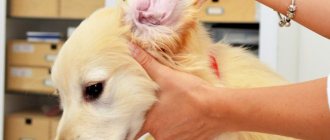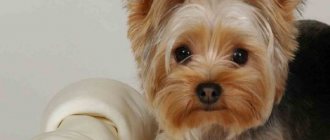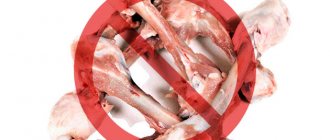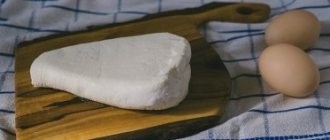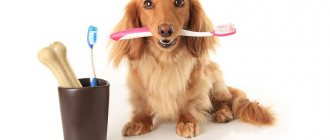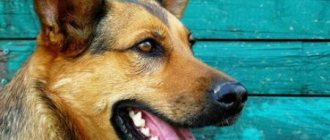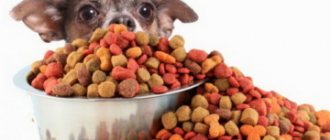Any pet requires taking care of its health. Yorkshire terriers were no exception. In addition to grooming, grooming and a balanced diet, these miniature dogs also need regular cleaning of their mouths.
Due to their anatomical features, Yorkies are prone to various dental diseases. Narrow jaws and the specific structure of the oral cavity lead to the formation of plaque, which subsequently turns into tartar. Therefore, the sooner you start accustoming your dog to hygiene measures, the better. Veterinarians recommend starting to monitor hygiene at the age of 3-4 months.
Failure to comply with hygiene rules leads to inflammatory processes in the oral cavity and, in advanced cases, to tooth loss. In addition to cleaning the mouth, owners need to remember how to care for Yorkie puppies.
How to brush your Yorkie's teeth at home?
Following several steps will help make hygiene measures easy and quick:
- Determine the right moment. You and your dog should be in a calm state and have enough time.
- Do not try to immediately climb into the dog’s mouth, gradually accustom him to touching.
- Introduce your puppy to brushing. At first, you don’t even need to use a special toothbrush. Initially, you can clean your teeth with gauze soaked in warm water, gently massaging them with your finger.
- When using the brush for the first time, do not try to act immediately. Let him get used to the new object, sniff it. Do not force it into the mouth under any circumstances, the animal will be frightened and will avoid repeated actions.
- Stop at cleaning a few teeth to give your dog time to get used to it.
- The movements are made in a circle, starting from the outer surface of the teeth. For the first time, 3-4 seconds will be enough, later the animal will get used to it, and the time can be increased.
- When the dog calms down, gradually increase the cleaning area. Do this very slowly and carefully so as not to cause pain.
- Brush at an angle of 45 degrees, paying special attention to the spaces between the teeth, where most of the food debris and bacteria accumulate.
- After each cleaning, be sure to praise your pet and reward it with treats.
Many owners are concerned about the question: how to brush a Yorkie’s teeth so as not to harm the baby’s health? The main thing is to choose the right main “tool” – a toothbrush.
There are several options:
- Children's "human" brush. It should be small in size with soft bristles. You should not purchase models with a floating head or other modern attributes, as this can harm the animal.
- Specialized model. They fit on your finger and are small in size, suitable for small mouths.
- Brushes with adjustable handle. The adjustable length allows you to get to even hard-to-reach places, and the soft bristles gently massage your gums without damaging them.
Video
Any pet requires taking care of its health. Yorkshire terriers were no exception. In addition to grooming, grooming and a balanced diet, these miniature dogs also need regular cleaning of their mouths.
Due to their anatomical features, Yorkies are prone to various dental diseases. Narrow jaws and the specific structure of the oral cavity lead to the formation of plaque, which subsequently turns into tartar. Therefore, the sooner you start accustoming your dog to hygiene measures, the better. Veterinarians recommend starting to monitor hygiene at the age of 3-4 months.
Failure to comply with hygiene rules leads to inflammatory processes in the oral cavity and, in advanced cases, to tooth loss. In addition to cleaning the mouth, owners need to remember how to care for Yorkie puppies.
Following several steps will help make hygiene measures easy and quick:
- Determine the right moment. You and your dog should be in a calm state and have enough time.
- Do not try to immediately climb into the dog’s mouth, gradually accustom him to touching.
- Introduce your puppy to brushing. At first, you don’t even need to use a special toothbrush. Initially, you can clean your teeth with gauze soaked in warm water, gently massaging them with your finger.
- When using the brush for the first time, do not try to act immediately. Let him get used to the new object, sniff it. Do not force it into the mouth under any circumstances, the animal will be frightened and will avoid repeated actions.
- Stop at cleaning a few teeth to give your dog time to get used to it.
- The movements are made in a circle, starting from the outer surface of the teeth. For the first time, 3-4 seconds will be enough, later the animal will get used to it, and the time can be increased.
- When the dog calms down, gradually increase the cleaning area. Do this very slowly and carefully so as not to cause pain.
- Brush at an angle of 45 degrees, paying special attention to the spaces between the teeth, where most of the food debris and bacteria accumulate.
- After each cleaning, be sure to praise your pet and reward it with treats.
Many owners are concerned about the question: how to brush a Yorkie’s teeth.
so as not to harm the baby’s health? The main thing is to choose the right main “tool” – a toothbrush.
There are several options:
- Children's "human" brush. It should be small in size with soft bristles. You should not purchase models with a floating head or other modern attributes, as this can harm the animal.
- Specialized model. They fit on your finger and are small in size, suitable for small mouths.
- Brushes with adjustable handle. The adjustable length allows you to get to even hard-to-reach places, and the soft bristles gently massage your gums without damaging them.
When choosing toothpaste, it is important to remember that fluoride causes serious food poisoning in Yorkies, so “human” products should not be used. In addition, Yorkshire terriers, like all animals, are very sensitive to smells and tastes. By choosing a scented toothpaste, you risk instilling in your pet an aversion to the cleaning procedure. It is necessary to use special products for dogs that do not contain additives or fluoride.
For the first cleaning, warm water with lemon juice or a weak solution of soda is suitable.
The sooner you begin to accustom your pet to the brushing process, the healthier his teeth will be. The best option is to start cleaning your teeth when the change from milk teeth to permanent teeth has not yet occurred. The procedure must be carried out once a week, at a certain time, so that the dog remembers the sequence of actions and does not worry.
In addition to plaque, tartar forms in the mouth. It must be removed depending on the age of the dog: in young dogs - at least once a year, in dogs older than three years - every six months.
The narrow mouth and closely spaced teeth of the Yorkshire Terrier mean that food particles often get stuck in the mouth, causing plaque and bad breath. This happens due to the lack of hard, “abrasive” food in the dog’s diet.
Preventative measures include:
- Adding foods to your diet to help get rid of stuck food pieces, such as chewy biscuits or seeds. Crackers or apples and hard carrots are also suitable for these purposes.
- Including tomato juice in food. Veterinarians recommend it as a good plaque cleaner. You can add finely chopped tomatoes to your food; Yorkies eat them with pleasure.
The Yorkshire Terrier, like dogs of other decorative breeds (Chihuahua, Toy, Spitz), due to its small size, has problems with teeth.
A Yorkshire Terrier puppy after changing teeth (after 7 months of age) needs regular teeth cleaning, because if you do not take care of your Yorkshire Terrier's teeth, this can lead to the formation of excessive plaque and tartar growth, gum disease and ultimately loss tooth To prevent plaque, you can use chewing bones for small breed dogs. Do not forget that the loss of teeth can further lead to digestive problems and unpleasant odor from the mouth. Try to brush your Yorkie's teeth daily if possible, or at least twice a week. Nowadays, pet stores have a very large selection of toothpastes and brushes for cleaning your pets’ teeth.
Step 1 – Choose the right time
Choose a quiet and comfortable place where you and your dog are in a calm, relaxed state.
Step 2 – Introducing your dog to teeth brushing
For several times it is better not to even use a toothbrush. You can start brushing your teeth by gently massaging your Yorkshire Terrier's gums with your finger, and only after the dog gets used to this procedure and feels comfortable, you can try brushing with toothpaste. Apply toothpaste to your finger and give your Yorkie a try. It is better to choose a flavored toothpaste for dogs because your pet needs to be able to taste the taste. Never use human toothpaste to clean. Small puppies will ingest the toothpaste, and fluoride can be dangerous.
Step 3 – Toothbrush
Apply a small amount of toothpaste to your brush. For the Yorkshire terriers of our kennel, we choose a toothbrush for small children; the brush is very soft and fits on the finger, and brushing the teeth with such a brush will cause minimal discomfort to the Yorkshire terrier. Using slow circular movements, start brushing a couple of teeth, the main thing is not to scare your pet, he should get used to the new procedure.
Step 4 – Start Cleaning
When York is accustomed to brushing at least two teeth with a toothbrush, then we gradually begin to increase the number of teeth. It is important that the brush eventually reaches the back teeth, where plaque and tartar are more likely to accumulate. You need to brush your teeth slowly and carefully, the main thing is not to hurt your pet, so that all your endeavors are not in vain.
Instructions
First you need to wait until the first baby teeth appear. At the age of 3-4, you can accustom your dog to oral hygiene. To do this, moisten the gauze and wipe the gums twice a day - morning and evening. Sometimes the teeth begin to grow in two rows, but this should not be a cause for concern unless the dog is a show dog.
Drinking tomato juice or eating tomatoes helps a lot. These products prevent the formation of tartar and plaque on teeth. Failure to maintain hygiene leads to bad breath from the dog. As a preventive measure, it is good to use artificial seeds, carrots or.
You need to buy a special toothbrush at a pet store. They are long, with bristles arranged in two rows and worn on a person’s finger. The soft effect of bristles on the gums has a massage effect and provokes the growth of permanent teeth. You need to buy toothpaste for dogs. There are products with various additives, for example with meat flavor or mint. The latter are not very popular with puppies. Such pastes do not require rinsing with water, they can be eaten and they do not contain substances that will negatively affect the digestive system of the Yorkshire Terrier.
After changing teeth (over 7 months), Yorkies should be given bones with the addition of chlorophyll once a week to prevent the formation of tartar.
You can use a mixture of baking soda and lemon juice, which must be rubbed into your Yorkie's gums daily, and also give him apples. You can use the following composition: mix a couple of drops of iodine with a spoonful of baking soda, add water and wipe the dog’s gums and teeth with this composition.
If the Yorkie is purebred and is intended for constant participation in exhibitions, it is very important to constantly monitor the hygiene of its mouth and brush its teeth. After all, healthy teeth and their completeness are a prerequisite for participation in the exhibition.
The future ring winner should be taught oral hygiene at the age of 3-4 months, even when the dog has baby teeth.
What is the best way to brush your Yorkie's teeth?
When choosing toothpaste, it is important to remember that fluoride causes serious food poisoning in Yorkies, so “human” products should not be used. In addition, Yorkshire terriers, like all animals, are very sensitive to smells and tastes. By choosing a scented toothpaste, you risk instilling in your pet an aversion to the cleaning procedure. It is necessary to use special products for dogs that do not contain additives or fluoride.
For the first cleaning, warm water with lemon juice or a weak solution of soda is suitable.
Care for Yorkies, choosing a puppy, mating, advice for beginners
1. If you don’t have a special brush for cleaning your dog’s teeth, you can do this:
wrap your finger with gauze or a bandage in 4-5 layers, apply paste to the fabric (You can use a plastic fingertip). We perform circular movements - wipe the teeth from the gums to the tips. We do this carefully: we try not to scratch the oral cavity or erase the enamel.
2. If the dog resists the procedure, you should start with a simple examination of the teeth, gradually moving on to the cleaning itself (after 1-2 weeks).
3. If you are completely unable to accustom your dog to this procedure, then it can be replaced by using oral and dental cleaning products - bones, chewing toys and ropes (but it is better to consult a veterinarian; it is still better to brush your Yorkie’s teeth).
Chewable bones made from corn meal are good for teeth and safe for the animal's digestive system. When choosing bones, the owner should take into account the size of the dog and the condition of its teeth, since large and hard bones can damage the oral cavity.
4. Brushing teeth with a special two- or three-sided brush for dogs. Don't use a brush that is too big. Choose a brush specifically for your dog. You will need to select a dental care product for the brush: paste, gel, spray, liquid, etc.
Brush your teeth for no more than 5 minutes, once a week. Try without paste first. Introduce your Yorkshire Terrier to something new. Then move on.
5. If tartar does appear, then special nutritional supplements for removing tartar will help remove it.
It is very important to keep your dog's teeth clean. Tartar prevents the access of oxygen to the tooth, which provokes the development of caries and tooth loss.
Please tell me what supplements and products are available to remove tartar? And then our Yorkie still has stones, just a little bit, on his fangs, we don’t know how to remove them, please tell me =(((
1. Add just a little tomato juice to your dog’s food.
2. Using something similar to scissors, carefully scrape off the formed tartar from the tooth. The dog will not like it, but this unpleasant procedure will take you about 3 seconds.
3. There are huge bones (fist bones) - raw.
4. If your Yorkie often gets stones, you will have to change his diet, or just buy a toothbrush and brush his teeth.
How often should you brush your Yorkie's teeth?
The sooner you begin to accustom your pet to the brushing process, the healthier his teeth will be. The best option is to start cleaning your teeth when the change from milk teeth to permanent teeth has not yet occurred. The procedure must be carried out once a week, at a certain time, so that the dog remembers the sequence of actions and does not worry.
In addition to plaque, tartar forms in the mouth. It must be removed depending on the age of the dog: in young dogs - at least once a year, in dogs older than three years - every six months.
How to train
You need to start caring for your oral cavity as early as possible. Already at two months of age the puppy is ready for this procedure. This is required not for hygienic reasons (teeth are finally formed only by 6-7 months), but rather for the psychological preparation of the animal. When the need for such cleaning is really great, the dog will already get used to it and will calmly accept your manipulations.
When teaching a dog to brush its teeth, it is important to choose the right time of day - you should not do it when the dog is excited, wants to walk, play, or is hungry. You need to wait until the animal calms down and relaxes. Usually this is the time after a walk and a meal. But you shouldn’t disturb a sleepy dog with such manipulations.
Training stages:
- From time to time, run your fingers near the dog's mouth so that this does not cause irritation in the future. The stage takes from 2-4 days to several weeks. Once you are sure that your fingers do not cause rejection in the animal, proceed to the next step.
- Apply dental cleaner to your finger and let your dog lick it. He must feel the taste of the gel or paste in order to adequately perceive it next time.
- As soon as the dog gets used to the new taste and atypical sensations, run your finger with the applied spray or mouth over the lips, teeth and gums.
- If the dog is accustomed to the taste of toothpaste, accustom him to the brush. Apply a little cleaner to it and let your dog lick it off. The taste will already be familiar to him, but this way he will become familiar with the feeling of the brush in his mouth. After each successful stage of training, reward the animal with a treat.
- If you understand that the dog is ready for oral hygiene, begin to carefully brush the teeth from the outside. Typically, cleaning begins with several teeth - fangs. If the dog shows anxiety, reassure him, but do not stop the procedure.
- Increase the number of teeth you brush every day. But don't do it too harshly. We always start with the place that you have already brushed before, and then gradually move on to other teeth.
- When brushing, always move the brush in one direction parallel to the gum.
- You should move on to cleaning the inside of your teeth only after the entire outside of your mouth has been cleaned. Getting used to cleaning the inside is carried out according to the same scheme as for the outside.
It is optimal if you perform oral hygiene for your dog every day. But this must be done at least once a week.
Prevention of diseases.
The narrow mouth and closely spaced teeth of the Yorkshire Terrier mean that food particles often get stuck in the mouth, causing plaque and bad breath. This happens due to the lack of hard, “abrasive” food in the dog’s diet.
Preventative measures include:
- Adding foods to your diet to help get rid of stuck food pieces, such as chewy biscuits or seeds. Crackers or apples and hard carrots are also suitable for these purposes.
- Including tomato juice in food. Veterinarians recommend it as a good plaque cleaner. You can add finely chopped tomatoes to your food; Yorkies eat them with pleasure.
Alternative to brushing your teeth
If you can’t train your dog to brush its teeth regularly, then at least use alternative methods. For example, you can buy special chewing toys. There are other ways to clean your mouth:
- Regularly play tug of war with the dog - by grabbing the rope with its teeth, the dog involuntarily frees itself from the remains of food.
- Periodically offer your animal bones, which are good for removing plaque.
- Rinse your mouth with water from a syringe or syringe, using herbal decoctions: chamomile, calendula.
You can also go to a veterinary clinic for ultrasonic teeth cleaning. This can be done 1-2 times a year. The procedure effectively removes plaque, stones, and destroys most bacteria. At the same time, the dog does not experience any discomfort.
To avoid plaque and tartar formation, buy special food that reduces the likelihood of these abnormalities. And don’t stop trying to teach your pet to brush his teeth normally.
You can also contact our site's staff veterinarian, who will respond to them as soon as possible in the comment box below.
When a pet appears in the house, it becomes a full member of the family, which means it must be cared for according to all the rules. Keeping a terrier is not an easy task; although the dog is small, caring for it is a great deal of daily work. Raising and caring for a Toy Terrier will require a lot of patience and creativity on your part, and is a great way for a young couple to test whether they are ready to have a child.
Toy Terrier: care and maintenance
If you want your dog to be healthy and well-groomed, it needs not only proper nutrition and cleanliness. Daily hygiene should be the same norm for dogs as for humans. Now let's take a closer look at how to care for that terrier:
- Toy terrier: ear care. Your pet's ears should be cleaned at least once a week. To care for your ears, you can use camphor alcohol or a special ear cleaner. Apply liquid to a cotton swab and penetrate into the ear no deeper than 0.5 cm. You need to drop a little lotion or alcohol into the ear and massage the base of the ear. Then clean off all the dirt. If necessary, repeat the procedure. While bathing, the ears should be covered with a cotton swab, and if discharge appears from the ears, immediately take the dog to the veterinarian.
- Caring for your Toy Terrier's teeth. Teeth are a dog's weakest point. Brushing your teeth is a must. The procedure can be carried out with a special toothpaste, or you can use a soft children's toothbrush. Brush your teeth at least once a week. Don't forget that your dog's baby teeth must be replaced by permanent ones. If a baby tooth does not fall out on its own before 12 months, consult a specialist. To take good care of your toy terrier, do everything as you would when raising a child. This will save the dog from losing teeth in the future.
- Toy terrier: eye care. Accustom your dog to daily morning washing. Eyes should be washed with boiled water. You can use a weak solution of chamomile for these purposes. Caring for a toy terrier requires the mandatory removal of all discharge from the eyes. After the procedure, you need to blot your eyes with a dry cloth and comb the hair with a toothbrush. To avoid eye inflammation, you can apply eye drops.
- Toy Terrier coat care. You need to wash your dog no more than once a month. You need to bathe your pet only with high-quality shampoo and conditioner for animals. The use of baby shampoo is allowed. If you are going to take your animal for vaccination, postpone bathing for a couple of weeks after vaccination; it is better to do it two days before vaccination. Caring for the Toy Terrier's coat involves using brushes only with natural bristles. Pay special attention to the areas behind the ears, elbows and chest. After combing, the hair is smoothed with a special mitten.
- Toy terrier: care and nutrition. You need to be very responsible in feeding your pet, because its food tract is very small. It is allowed to feed your dog canned food or dry dog food, but you need to choose very carefully and give preference only to proven and expensive brands. Offer your dog raw scalded liver or a piece of beef. You can give kefir or boiled eggs, cottage cheese. If you decide not to bother with cooking and feed only ready-made canned food, be sure to add vitamin supplements to your diet.
Toy Terrier: puppy care
With the appearance of this small and fragile creature in your home, you need to introduce some changes into your usual rhythm of the day. Be sure to buy your puppy a small collar with a bell. Most often, the dog follows on the heels of the owner, it is very easy not to notice and step on the baby.
Never pick up an animal with one hand, only with both. Caring for and maintaining a toy terrier is often reminiscent of caring for a baby. Feed by the hour, bathe and clean very carefully and according to all the rules. Never leave your dog alone in the car. When walking, be especially careful that street cats and dogs do not come close to your pet.
Changing baby teeth
After four months, the baby Yorkie begins to lose its baby teeth. The incisors change first, then the canines. Incisors usually fall out unnoticed. Changing canines is a more complex process.
Requires utmost attention. The owner should be aware of how many molars an eight-month-old Yorkie should have.
If the fangs have not fallen out by the end of the 7th month, you should immediately contact a veterinarian.
Permanent teeth grow through a canal formed in place of fallen milk teeth.
Incorrect replacement of the Yorkie's teeth leads to uneven row growth. This pathology can be a consequence of both an incorrect diet and the dog’s genetic predisposition.
Reasons also include improper jaw formation and poorly developed chewing apparatus of the puppy.
There is a case when the root of a baby tooth in an animal does not disappear before the molar begins to grow.
Then a phenomenon is observed in which the molars line up in a row with the milk teeth. The phenomenon is not safe and leads to serious injuries to the dog’s gums, jaw and tongue
.
Therefore, in case of such a deviation, you should immediately contact a veterinarian, who, with the help of surgical intervention, will resolve the issue of what is done under local or general anesthesia.
The doctor chooses the type of anesthesia based on the dog’s health condition, also taking into account the length of the root of the tooth being removed.
Delayed teeth change
Yorkshire terrier puppies sometimes experience retention - a pathology when, after the baby tooth falls out, the permanent tooth does not grow at all.
This occurs due to the absence of a molar tooth germ, or its incorrect location.
Incorrect removal of previous primary teeth can also cause abnormal growth of permanent teeth.
How many teeth should a healthy adult Yorkie have?
?
- Upper jaw:
- incisors (six);
- fangs (two);
- molars (two).
- incisors (six);
- fangs (two);
- premolars (eight), of which two are small and two are large on both sides;
- molars (three).
Lower jaw:
And there are 42 permanent teeth.
You can take care of your Yorkie's teeth only after all of the animal's permanent teeth have been cut.
Care is carried out according to the following rules
:
Clean your puppy's teeth every seven days in a specialized salon or by a specialized veterinarian.
The right choice of toothpaste, taking into account the dog’s individual tolerance to its components.
Including chewing bones in your dog's diet will allow your Yorkie to clean his teeth on his own, thereby preventing the formation of caries and tartar in him.
Every ten days, teeth should be wiped with a handkerchief dipped in hydrogen peroxide. This will help keep your puppy's teeth white.
Dental health is a serious indicator of the condition of the puppy’s entire body. That is why it is necessary to be extremely attentive to changing your dog’s teeth, thereby protecting him from further problems.
